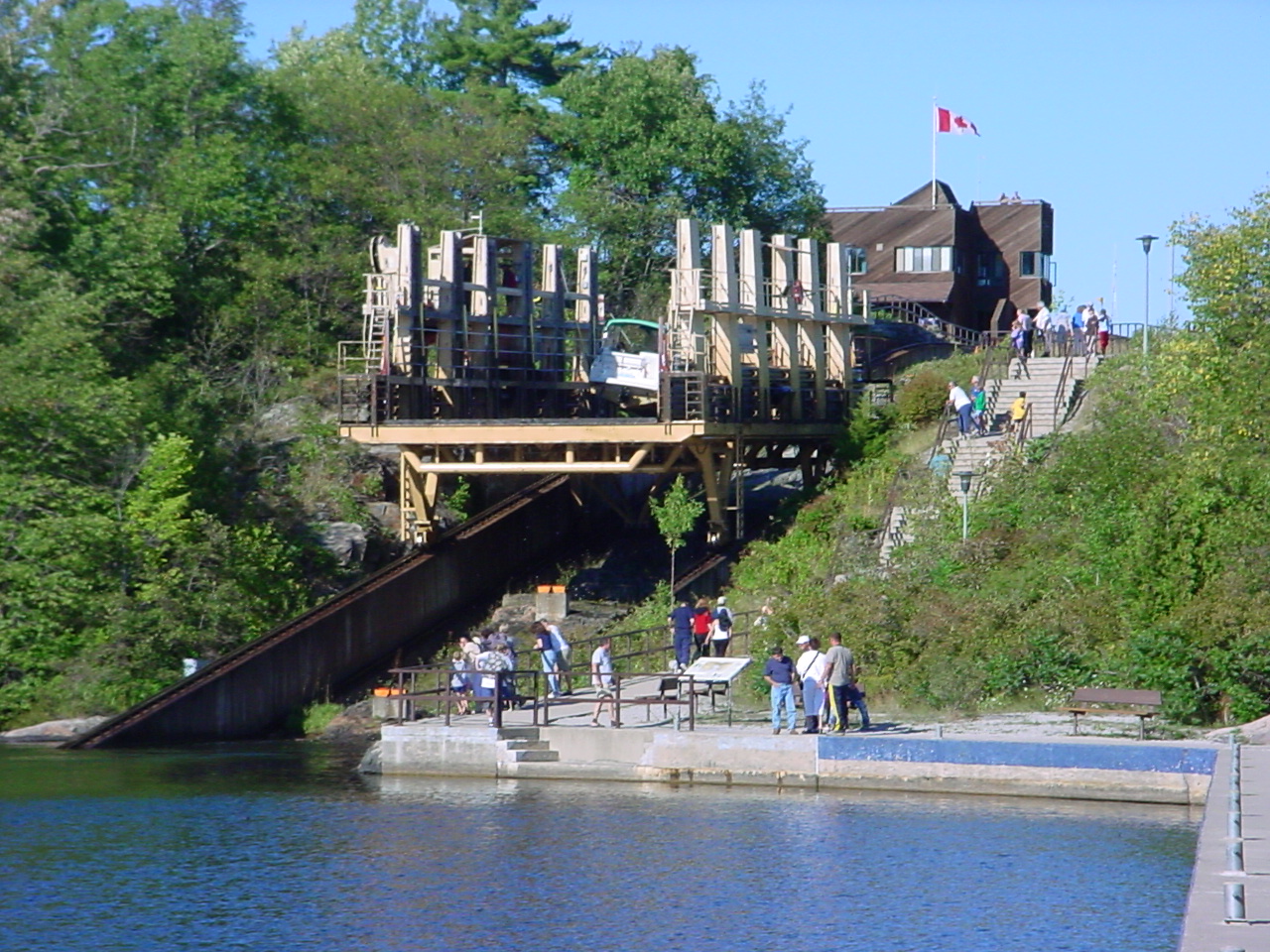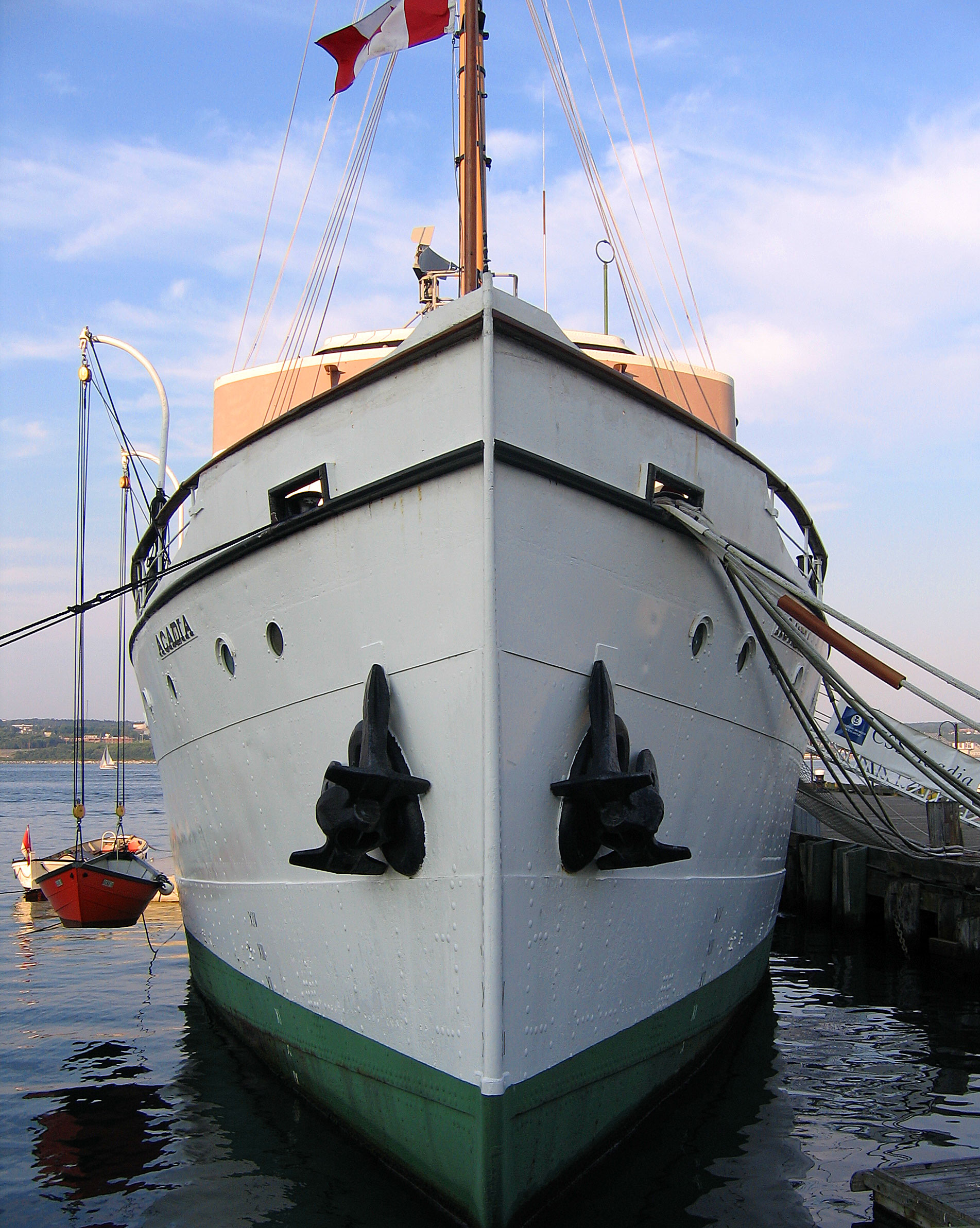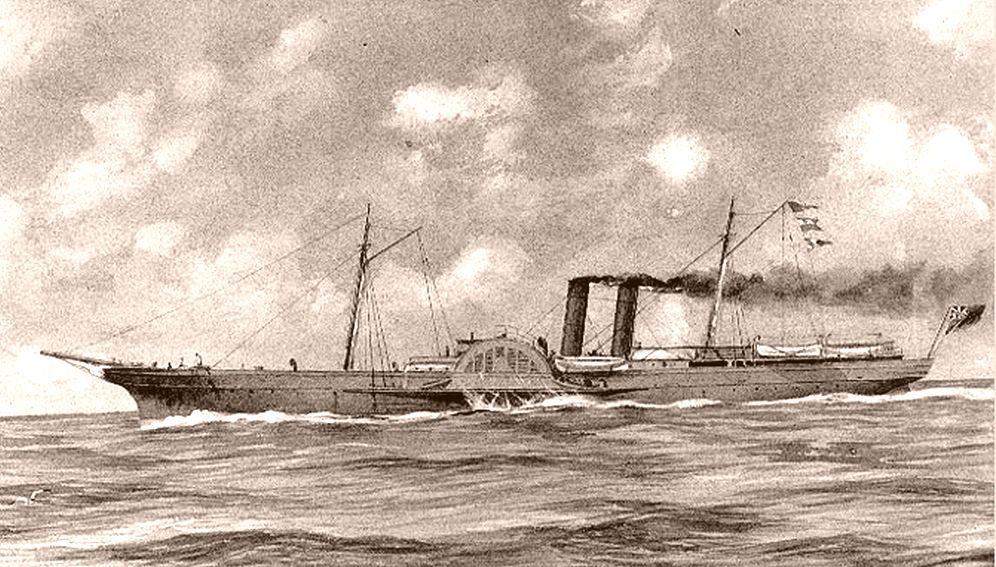|
Dartmouth Marine Slips
The Dartmouth Marine Slips was an historic shipyard and marine railway which operated in Dartmouth, Nova Scotia between 1859 and 2003. It was noted for important wartime work during the American Civil War as well as during the Battle of the Atlantic in World War II. After its closure, the site began redevelopment as King's Wharf, a high-rise residential development. Origins The Dartmouth Marine Slips were opened as the Chebucto Marine Railway in 1859 under the supervision of an American engineer, H.I. Crandall. His plans to use bilge and keel blocks to operate in conjunction with the current marine railway to haul ships in and out of the water was genius. The construction and operation of the Chebucto Marine Railway would not have been possible without the following investors: U.S. Consul Albert Pillsbury; Robert Boak of Boak, Taylor and Co.; and John Wyide of Wier and Co. The Chebucto Marine Railway was frequently used by merchant vessels and, at times, the Royal Navy. It enjo ... [...More Info...] [...Related Items...] OR: [Wikipedia] [Google] [Baidu] |
Marine Railway
The patent slip or marine railway is an inclined plane extending from shoreline into water, featuring a "cradle" onto which a ship is first floated, and a mechanism to haul the ship, attached to the cradle, out of the water onto a slip. The marine railway was invented by a Scot, Thomas Morton, in the early 19th century, as a cheaper alternative to dry docks for marine vessel repairs, in particular below waterline. Larger modern marine railways can handle vessels of thousands of tons. History Invented by shipwright Thomas Morton in 1818, the marine railway offered an alternative to the expensive and time-consuming process of dry docking a ship to perform maintenance or repairs to its hull below waterline. The means and mechanisms over time became various, but always include a "cradle" onto which the ship is floated, and a mechanical mechanism for transferring the ship from water to land up an incline. The destination where work was performed was termed the slip. Thomas Morto ... [...More Info...] [...Related Items...] OR: [Wikipedia] [Google] [Baidu] |
Royal Canadian Navy
The Royal Canadian Navy (RCN; french: Marine royale canadienne, ''MRC'') is the Navy, naval force of Canada. The RCN is one of three environmental commands within the Canadian Armed Forces. As of 2021, the RCN operates 12 frigates, four attack submarines, 12 coastal defence vessels, eight patrol class training vessels, two offshore patrol vessels, and several auxiliary vessels. The RCN consists of 8,570 Regular Force and 4,111 Primary Reserve sailors, supported by 3,800 civilians. Vice-Admiral Angus Topshee is the current commander of the Royal Canadian Navy and chief of the Naval Staff. Origins of the Royal Canadian Navy, Founded in 1910 as the Naval Service of Canada (French: ''Service naval du Canada'') and given royal sanction on 29 August 1911, the RCN was amalgamated with the Royal Canadian Air Force and the Canadian Army to form the Unification of the Canadian Forces, unified Canadian Armed Forces in 1968, after which it was known as Maritime Command (French: ''Commandemen ... [...More Info...] [...Related Items...] OR: [Wikipedia] [Google] [Baidu] |
Halifax Shipyard
The Halifax Shipyard Limited is a Canadian shipbuilding company located in Halifax, Nova Scotia. Founded in 1889, it is today a wholly owned subsidiary of Irving Shipbuilding Inc. and is that company's largest ship construction and repair facility. History Halifax Graving Dock Company 1889–1918 The Halifax Graving Dock Company was formed by English investors who constructed the graving dock for $1 million, opening on September 21, 1889 on the western shore of Halifax Harbour in the community of Richmond. The following year on August 22, 1890 the Halifax Graving Dock Company purchased the Chebucto Marine Railway Company Limited located in Dartmouth Cove, at the mouth of the former Shubenacadie Canal in Dartmouth. The yard built a small steam tug for its own use in 1915, the tug ''Sambro''. During World War I, the Halifax Graving Dock Company's facilities on the Halifax side of the harbour were badly damaged by the December 6, 1917 Halifax Explosion, which occurred n ... [...More Info...] [...Related Items...] OR: [Wikipedia] [Google] [Baidu] |
Irving Shipbuilding
Irving Shipbuilding Inc. is a Canadian shipbuilder and in-service support provider. The company owns industrial fabricators Woodside Industries in Dartmouth, Marine Fabricators in Dartmouth, Halifax Shipyard as the largest facility and company head office as well as Halifax-based Fleetway Inc., an engineering and design, support and project management firm. Irving Shipbuilding Inc. was incorporated in 1959 and is headquartered in Halifax, Nova Scotia, Canada. The company operates as a subsidiary of J.D. Irving Limited. History Foundation The company's history began in 1959, when K.C. Irving purchased Saint John Shipbuilding which was renamed Irving Shipbuilding. 20th-century developments In 1994, Irving Shipbuilding bought the Halifax-Dartmouth Industries Limited in Halifax, Nova Scotia, creating Canada's largest shipbuilding company. Later, the management renamed the yard to Halifax Shipyard Limited. At the same time the company acquired the East Isle Shipyard, a facility ... [...More Info...] [...Related Items...] OR: [Wikipedia] [Google] [Baidu] |
CSS Acadia
CSS ''Acadia'' is a former hydrographic surveying and oceanographic research ship of the Hydrographic Survey of Canada and its successor the Canadian Hydrographic Service. ''Acadia'' served Canada for more than five decades from 1913 to 1969, charting the coastline of almost every part of Eastern Canada including pioneering surveys of Hudson Bay. She was also twice commissioned into the Royal Canadian Navy (RCN) as HMCS ''Acadia'', the only ship still afloat to have served the RCN in both World Wars. Today she is a museum ship, designated as a National Historic Site of Canada, moored in Halifax Harbour at the Maritime Museum of the Atlantic. History ''Acadia'' was designed in Ottawa by Canadian naval architect R.L. Newman for the Hydrographic Survey of Canada and built by Swan Hunter & Wigham Richardson at Newcastle-on-Tyne in England. Named after Acadia, the early colonial name for Atlantic Canada, she was launched on May 8, 1913. ''Acadia'' arrived in Halifax on July ... [...More Info...] [...Related Items...] OR: [Wikipedia] [Google] [Baidu] |
Canadian Coast Guard
The Canadian Coast Guard (CCG; french: links=no, Garde côtière canadienne, GCC) is the coast guard of Canada. Formed in 1962, the coast guard is tasked with marine search and rescue (SAR), communication, navigation, and transportation issues in Canadian waters, such as navigation aids and icebreaking, marine pollution response, and support for other Canadian government initiatives. The coast guard operates 119 vessels of varying sizes and 23 helicopters, along with a variety of smaller craft. The CCG is headquartered in Ottawa, Ontario, and is a special operating agency within Fisheries and Oceans Canada (Department of Fisheries and Oceans). Role and responsibility Unlike armed coast guards of some other nations, the CCG is a government marine organization without naval or law enforcement responsibilities. Naval operations in Canada's maritime environment are exclusively the responsibility of the Royal Canadian Navy. Enforcement of Canada's maritime-related federal statutes ma ... [...More Info...] [...Related Items...] OR: [Wikipedia] [Google] [Baidu] |
Atlantic Canada
Atlantic Canada, also called the Atlantic provinces (french: provinces de l'Atlantique), is the region of Eastern Canada comprising the provinces located on the Atlantic coast, excluding Quebec. The four provinces are New Brunswick, Newfoundland and Labrador, Nova Scotia, and Prince Edward Island. As of 2021, the landmass of the four Atlantic provinces was approximately 488,000 km2, and had a population of over 2.4 million people. The provinces combined had an approximate GDP of $121.888 billion in 2011. The term ''Atlantic Canada'' was popularized following the admission of Newfoundland as a Canadian province in 1949. History The first premier of Newfoundland, Joey Smallwood, coined the term "Atlantic Canada" when Newfoundland joined Canada in 1949. He believed that it would have been presumptuous for Newfoundland to assume that it could include itself within the existing term "Maritime provinces," used to describe the cultural similarities shared by New Brunswick, Prince ... [...More Info...] [...Related Items...] OR: [Wikipedia] [Google] [Baidu] |
CSS Acadia, Halifax Harbour
Cascading Style Sheets (CSS) is a style sheet language used for describing the presentation of a document written in a markup language such as HTML or XML (including XML dialects such as SVG, MathML or XHTML). CSS is a cornerstone technology of the World Wide Web, alongside HTML and JavaScript. CSS is designed to enable the separation of content and presentation, including layout, colors, and fonts. This separation can improve content accessibility; provide more flexibility and control in the specification of presentation characteristics; enable multiple web pages to share formatting by specifying the relevant CSS in a separate .css file, which reduces complexity and repetition in the structural content; and enable the .css file to be cached to improve the page load speed between the pages that share the file and its formatting. Separation of formatting and content also makes it feasible to present the same markup page in different styles for different rendering methods ... [...More Info...] [...Related Items...] OR: [Wikipedia] [Google] [Baidu] |
Convoys
A convoy is a group of vehicles, typically motor vehicles or ships, traveling together for mutual support and protection. Often, a convoy is organized with armed defensive support and can help maintain cohesion within a unit. It may also be used in a non-military sense, for example when driving through remote areas. Naval convoys Age of Sail Naval convoys have been in use for centuries, with examples of merchant ships traveling under naval protection dating to the 12th century. The use of organized naval convoys dates from when ships began to be separated into specialist classes and national navies were established. By the French Revolutionary Wars of the late 18th century, effective naval convoy tactics had been developed to ward off pirates and privateers. Some convoys contained several hundred merchant ships. The most enduring system of convoys were the Spanish treasure fleets, that sailed from the 1520s until 1790. When merchant ships sailed independently, a privateer could ... [...More Info...] [...Related Items...] OR: [Wikipedia] [Google] [Baidu] |
Dartmouth, Nova Scotia
Dartmouth ( ) is an urban community and former city located in the Halifax Regional Municipality of Nova Scotia, Canada. Dartmouth is located on the eastern shore of Halifax Harbour. Dartmouth has been nicknamed the City of Lakes, after the large number of lakes located within its boundaries. On April 1, 1996, the provincial government amalgamated all the municipalities within the boundaries of Halifax County into a single-tier regional government named the Halifax Regional Municipality (HRM). Dartmouth and its neighbouring city of Halifax, the town of Bedford and the Municipality of the County of Halifax were dissolved. The city of Dartmouth forms part of the urban core of the larger regional municipality and is officially designated as part of the "capital district" by the Halifax Regional Municipality. At the time that the City of Dartmouth was dissolved, the provincial government altered its status to a separate community to Halifax; however, its status as part of the metrop ... [...More Info...] [...Related Items...] OR: [Wikipedia] [Google] [Baidu] |
Blockade Runners Of The American Civil War
The blockade runners of the American Civil War were seagoing steam ships that were used to get through the Union blockade that extended some along the Atlantic and Gulf of Mexico coastlines and the lower Mississippi River. The Confederate states were largely without industrial capability and could not provide the quantity of arms and other supplies needed to fight against the industrial north. To meet this need blockade runners were built in Scotland and England and were used to import the guns, ordnance and other supplies that the Confederacy desperately needed, in exchange for cotton that the British textile industry needed greatly. To penetrate the blockade, these relatively lightweight shallow draft ships, mostly built in British ship yards and specially designed for speed, but not suited for transporting large quantities of cotton, had to cruise undetected, usually at night, through the Union blockade. The typical blockade runners were privately owned vessels often operatin ... [...More Info...] [...Related Items...] OR: [Wikipedia] [Google] [Baidu] |
Albert E
Albert may refer to: Companies * Albert (supermarket), a supermarket chain in the Czech Republic * Albert Heijn, a supermarket chain in the Netherlands * Albert Market, a street market in The Gambia * Albert Productions, a record label * Albert Computers, Inc., a computer manufacturer in the 1980s Entertainment * ''Albert'' (1985 film), a Czechoslovak film directed by František Vláčil * ''Albert'' (2015 film), a film by Karsten Kiilerich * ''Albert'' (2016 film), an American TV movie * ''Albert'' (Ed Hall album), 1988 * "Albert" (short story), by Leo Tolstoy * Albert (comics), a character in Marvel Comics * Albert (''Discworld''), a character in Terry Pratchett's ''Discworld'' series * Albert, a character in Dario Argento's 1977 film ''Suspiria'' Military * Battle of Albert (1914), a WWI battle at Albert, Somme, France * Battle of Albert (1916), a WWI battle at Albert, Somme, France * Battle of Albert (1918), a WWI battle at Albert, Somme, France People * Albert (given ... [...More Info...] [...Related Items...] OR: [Wikipedia] [Google] [Baidu] |



.jpg)




.jpg)
